

|
Home Updates Hydros Cars Engines Contacts Links Page 1 Next→ |
Internal Combustion Pioneer
W. J. ‘Belvedere’ Smith
|
|
Although tethered hydroplane racing as we now know it started with Herbert Teague in 1908, Model Engineer magazine had been running an annual competition for model speedboats since 1902. Initially called the ‘Steamer’ competition, reflecting the nature of the entries, it was later renamed the ‘Model Engineer Speedboat Competition’. This would always be a postal event as the first organised model speedboat regatta did not take place until July 1908, when Model Engineer organised an event at Wembley. In the 1902 competition, all nine entries were steamboats, with the fastest speed being 5mph. The internal combustion engine was still in its infancy, yet 5 years later would hold the outright speed record for model boats. The leading exponents of this new form of power were the Arkell brothers with their ‘Moraima’ series of boats who went on to win the ‘Unlimited’ class at the inaugural speedboat regatta at 9.26mph. F.N. Sharp who was Second in the Wembley event with ‘Varuna’ and W.J. Smith, third with his boat ‘Belvedere’. Both Sharp and Smith would go on to develop and then sell their engines commercially, yet Smith holds something of a unique distinction in that he was known from 1908 on as ‘Belvedere’ Smith, after his boat. |
Smith was certainly a pioneer in the use of small internal combustion engines in models and members of the Victoria Model Steamboat Club would use his motors to good effect for many years to come. Unlike Sharp, whose involvement with tethered hydroplanes continued into the 30s, Smith effectively vanished from the scene just before the First War. A chance find on eBay and an email from across the Atlantic determined us to discover more about ‘Belvedere’ Smith and his involvement with model engines and boats.
William Joseph Smith was born in Bethnal Green in East London on 10th March 1878, to Sidney Smith of Holborn and his wife Sarah, originally from Stroud in Gloucestershire. William was the eldest of 6, with two brothers, Herbert and John, and three sisters, Rose, Florence and Peace. By 1891, the family had moved from Cambridge Road in Bethnal Green to Harvist Mews, just off the Hornsey Road in Islington. The Mews was a small area of stables and carriage sheds with accommodation above belonging to properties in Harvist Road. The Smith family lived at number 10. Sidney Smith was a carpenter and joiner by trade, yet the first evidence we have of William at work is as a ‘carman’, which meant at that time, that he was driving a horse drawn van or cart of some sort. As would be expected living in a mews, many of William’s neighbours were also carmen, coach drivers and grooms.
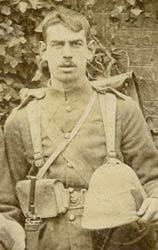 |
 |
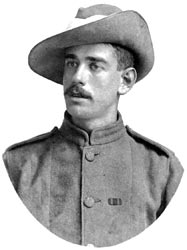 |
The years around the turn of the 20th Century were somewhat turbulent for both Britain and the Smith family. Sydney died in 1900, aged just 48, Sarah and the children moved up to the top end of the Hornsey Road to live at number 384, along with Alfred Sale, a grocer and cheesemonger. William had followed in his father’s footsteps by becoming a carpenter as well, but would soon find himself fighting against the Boers in South Africa. He had joined the 2nd Tower Hamlets Royal Engineer Reserve and was called up on 24th January 1900. By the 10th March, he was serving in South Africa as a sapper with the Royal Engineers. After his years engagement he was shipped home and discharged on 29th April 1901.
|
Before his Army service William had met Alice Biggs who lived close by in Orpingley Road. Just 4 weeks after his return from the war they were married in St Mark’s Church, Tollington Park on 26th May 1901, setting up home at 323 Hornsey Road. Their first daughter Lilian Florence was born in 1902 followed by Ethel Peace in 1906, Jessie Edith in 1910 who died a few months later, and Jessie Violet in 1911. It seems however that William’s career might have taken the path away from carpentry following his discharge from the Army. Alice’s father, John Biggs was a tinplate worker and later worked in a foundry, and with William having served in the Royal Engineers it is likely that his thoughts were drawn to some form of engineering or metalworking discipline. Certainly he was involved with the Victoria Model Steamboat Club at Victoria Park and became acquainted with Ted Vanner, Herbert Groves, Fred Westmoreland, the Arkell brothers, William Blaney and others who were in the forefront of the development of fast model boats. |
|
There is no definitive evidence of who first used a small internal combustion engine in a model boat as development seemed to be running in parallel in several places, both by amateur enthusiasts and commercial firms. Certainly the Arkell brothers had Moirama up to around 8mph for the 1906 ME competition. Their single cylinder four-stroke was a massive 51cc capacity, lying horizontally in the hull, driving two propellors through a complex system of gears.
|
Almost every competitor used the horizontal layout, as the motors were tall and very heavy, making vertical mounting undesirable. At this stage there was a clear divide becoming evident between those building functional boats for speed and those following a more scale route. From the design and layout of Smith’s boat, it was obvious he was in search of speed. The engine he came up with was a relative monster at a shade under 85cc. The crankcase casting was designed with two large mounting plates either side to allow the engine to still be mounted horizontally, but with the crankshaft vertical. This enabled him to use a simple bevel drive to the propshaft rather than the complicated system preferred by the Arkells. The single cylinder was water cooled by thermo siphon with an automatic, atmospheric inlet valve and a push rod operated exhaust valve. A trembler coil and lead acid accumulator, both adding considerably to the weight of the plant, provided the sparks. Induction was by surface evaporation with the incoming air passing through a container of petrol. Right: 'Birds eye view' of engine in Belvedere |
|
|
|
It was at the 1908 Wembley Regatta that the names ‘Belvedere’ and W.J. Smith came to prominence, with his third place in the largest class at 5.11mph. Failing any more precise explanation the assumption is that the Belvedere name came from the area on the Hornsey Road where Smith lived or worked. Certainly there was a pub in the vicinity called the Belvedere and other businesses using that name. By 1909 Smith had adopted that name also for his works and motors. His boat ‘Belvedere’ became one of the best known on the waters of London to such an extent that his friends and acquaintances called him ‘Belvedere’ Smith from then on. |
|
These were not however Smith's first engines as the design and photographs of an engine he had built were published in Model Engineer in 1907. The article describes how he converted a German toy gas engine into an IC motor with an automatic inlet valve over a cam operated exhaust valve. From the dimensions given this engine was around 14cc, significantly smaller than the one he built for 'Belvedere' The 1909 National Regatta as it had become, was held at the Long Pond on Clapham Common. The premier award was the Wembley Park Challenge Cup, which was won by a team from the Victoria Club comprising, Ted Vanner with Leda IV, Smith with Belvedere II and Jim Crebbin with Edouard Sauvage. |
|
|
|
The dominance of the IC engine was very short lived, as in quick succession Herbert Teague and Vernon Delves Broughton developed a workable flash steam plant, the stepped hydroplane hull was adopted and Teague decided for reasons of convenience to run his boat in a circular course round a pole. A year after the Arkells had set the record with an IC motor, it was upped to 13mph, then 15mph and in the 1909 Speedboat Competition to a remarkable 19.76mph by flash steam powered boats. Many competitors, including Smith continued to persevere with the IC motors, but it would be another 27 years before they were developed sufficiently to beat the steamers. Left: Watercolour by Herbert Teague of 'Belvedere' running in 1909 |
|
Teague’s run of 19mph won the Gold medal in the 1909 competition, but silver was won by W.J. Smith at 12.94mph, more than double his 1908 speed. Happily, he submitted a brief description of his boat, engine, and run, to go along with the speed certificate from the Club. |
|
The Victoria Model Steamboat Club
Entry for the Model Engineer Speedboat Competition, 1909
Name of Boat.-Belvedere
II
Name of Owner,
Builder and Designer.- W.J. Smith
Length.- Overall
and L.W.L 5ft 9ins
Beam.-10 ½ins
Depth.- 4 ¼ins
Power.- Petrol,
2hp rated
Date of Trials.-
Sunday December 26th 1909
Performance.-
Eight rounds on a circular course.
Radius of Circle.-
43ft 6ins
Time.- 115
seconds
Witnessed by
W. Poole (Secretary) and about 1,000 of the public.
Timed by W.L.
Blaney, Chairman V.M.S.C.
Checked by E. Vanner.
In his comments, Smith remarked that it was his first attempt at running on the circular course and that he had not yet found the right position for the tethering eye. He also concluded that the circle was too small to allow the very long boat to lift. Technical details included the bore and stroke of the engine both at 1 7/8thins, the prop diameter and pitch at 4in x 13 ½ins and that the hull was a ‘sharpie’ design, rather than a hydroplane.
|
It is interesting that Smith had decided to run his boat on the circular course, yet as speeds increased it was becoming a matter of safety as an A class boat weighing some 30lbs or more travelling at that sort of speed would require a very brave stopper. As an aside, it is fascinating that there are several accounts of boats being run at Victoria over the Christmas period, including this run on Boxing Day. The IC engine had been eclipsed as far as high-speed work in hydroplanes was concerned, but there were still a very large market for ready built motors or castings for straight running and scale boats, especially in London. |
|
Running model boats was exceedingly popular with clubs at Victoria, Forest Gate, Clapham and South London to name a few. Through his Belvedere Engineering Company at 441 Hornsey Road, Smith was soon selling a range of differing types and sizes of engine, not only for models, but home and industrials use, and in particular for home generation of electricity.
|
|
In 1909 he was offering the No1 and No3 OHV units, which presumably were similar to the motor in his own boat, although in two capacities. Adverts he placed in the Model Engineer stated: "Model Petrol Motors; lightest on the market. Don’t put a motor weighing a ton into a model boat and expect speed. Illustrated list, stamp. BELVEDERE ENGINEERING Co. 441 Hornsey Road Holloway." Interestingly, another advert in the same issue offers motor cycle parts from 'Belvedere Works' at 268 Hornsey Road. Left: Smith's stand at
the 1911 Model Engineer Exhibition. Interestingly the address is now
453a |
|
The new address seems to be a result of Smith being joined in partnership with a Mr Wilson and taking the additional premises in Holloway Road. In an advert, again in Model Engineer, it also gives an address for the Belvedere Model Motor Works at 7, Andover Yard, 219 Hornsey Road. This advert mentions winning first prize in the 'Model Boat Regatta' with 'the metre boat Baby, fitted with one of our small engines.' By 1913 he had added four more single cylinder units to the range, in 33cc, 50cc, 70cc and 90cc sizes. In common with other manufacturers, crankcases were available to mount two cylinders horizontally opposed to double the capacity. The advert right also offers model sparking plugs at 2/- (ten pence). |
|
In a Model Engineer article in 1923 Fred Westmoreland commenting on the lack of effective plugs for small engines said that " a very good little plug with mica insulation, used to be made by W J Smith of Belvedere model petrol motor fame. Unfortunately this type of plug is not now made."
An advert in December 1913 offers motor cycle and light car parts from S.H. Motor Works, also in Andover Yard, which does seem something of a coincidence given the earlier mention of 'Belvedere Works' selling motor cycle parts. This gives rise to the possibility that the production of motors was not his only interest, as in 1911 he had described himself as a Model Engineer, which would indicate a much wider range of activities and interests. Percival Marshall described him as "A stalwart supporter of the Victoria Club and a whole hearted enthusiast in model making who did yeoman service in stimulating interest in speed boat building." As further confirmation of his support for the Victoria Club in 1913 Smith donated one of his Belvedere petrol motors as a prize at the first ever Sunday meeting at the Park. The motor was won by a Mr G Scott with his boat 'QT'.
A regular customer of Smith’s was Ted Vanner from Lewisham, who used Belvedere castings to create one of the most successful and famous boats of all times ‘Leda III’. Leda was built in 1909 and steam powered, but an identical hull built in the same year was fitted with a horizontally mounted single cylinder ‘Belvedere’ motor in place of the steam plant.
|
Leda III with top removed to show the engine room |
The new hull, also called 'Leda III', would win an incredible number of competitions over the next 40 years. The tinplate hydroplane hull was used for straight running and circular course events all over the country and abroad. Ted would take the boat on the overnight train to a lake in Newcastle, Cardiff or even Scotland. The engine was started with a twist of the key and Ted would put on a one-man exhibition of model boating. Remarkably, Leda has survived with its original motor to provide a tangible link with W.J. Smith. |
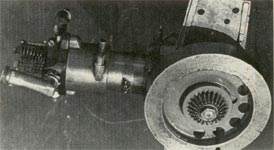 |
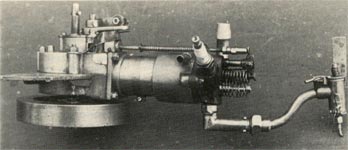 |
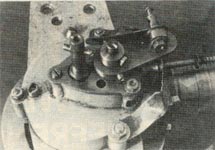 |
| Leda's motor now over 100 years old | ||
Page 2 Next→
©copyrightOTW2011